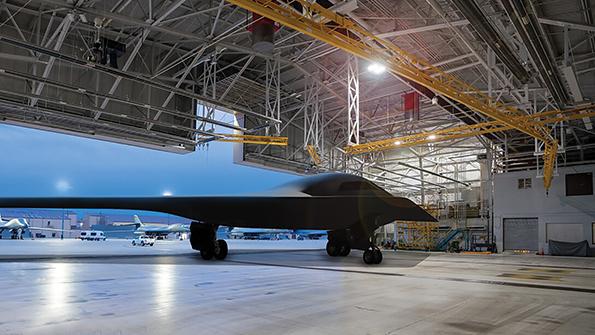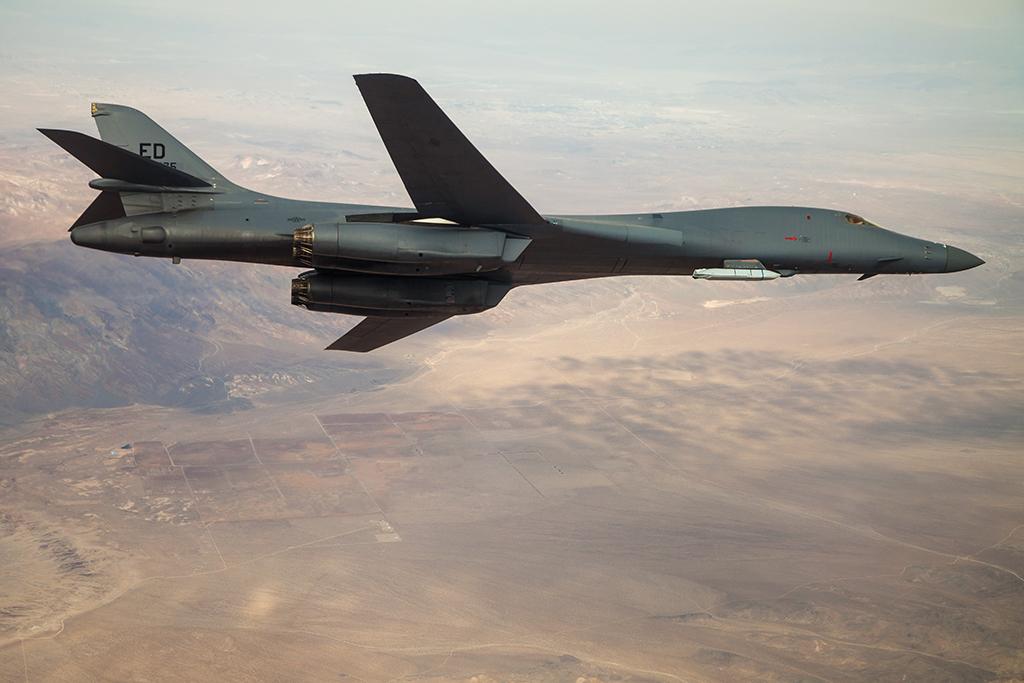
Strategic bombers are enjoying a stealthy renaissance against a backdrop of renewed competition among “great power” states: namely, the U.S., China and Russia.
For more than a decade, all three countries have labored to push a new generation of stealth bombers into service under programs cloaked in secrecy, while at the same time expanding the capacity and quality of an aging bomber fleet. The first fruits of the new stealth-bomber generation may become visibly tangible to the public in 2021.
- Secret bomber programs are set for possible rollout in 2021
- Cold War-era bomber fleets receiving major upgrades
Although the U.S. Air Force has backed off from a schedule revealed in July 2018 to fly the Northrop Grumman B-21 Raider for the first time on Dec. 4, 2021, the first aircraft still may emerge from Building 401 on Site 4 at Plant 42 in Palmdale, California, during the next 12 months.
The Air Force’s new schedule calls for first flight of the B-21 in 2022. Given the traditional 6-9-month period of outdoor ground testing in advance of any first flight by a new aircraft, the updated schedule still implies a strong chance of a factory rollout during the second half of 2021.
Less is known of the construction status of China’s first stealthy, flying-wing bomber, probably named the H-20. Since 2018, the U.S. Defense Department has estimated in annual reports to Congress that the H-20 is likely to be a stealthy, subsonic bomber resembling the Northrop B-2 or X-47B, with a range of at least 4,590 nm (8,500 km) and payload capacity of conventional and nuclear munitions totaling at least 10 metric tons. In 2019, the department added that the H-20 could “debut” during the 2020s.
If the Pentagon’s range estimate for the H-20 is accurate, it falls well short of the U.S. West Coast but encompasses most of the northern Pacific Ocean, including Alaska and Hawaii. A rollout and first flight remain possible in 2021. A corporate video by the Aviation Industry Corp. of China, the H-20’s corporate developer, released at the end of 2019 teased that the H-20’s unveiling would come “shortly.”
In Russia, the Prospective Aviation Complex for Long-Range Aviation (PAK DA) bomber likely transitioned into the production phase during 2020. Satellite photos in early spring revealed a large new factory being erected inside Tupolev’s industrial complex in Kazan. By May, major structural assemblies for the first test aircraft had entered construction, according to a report by TASS. The same report, citing two anonymous sources inside Russia’s defense industry, put the schedule for completing final assembly in 2021.
All three programs represent the first new bomber designs initiated since the Cold War. Service-entry schedules for the three have not been announced but will be coming around 30 years after Northrop’s first-generation stealth bomber—the flying-wing, four-engine B-2A—became operational in 1997.
The impact on the defense industry could be profound as production ramps up over the next decade.
For the B-21, low-rate initial production should begin in 2022, Northrop CEO Kathy Warden says. That timetable suggests production-aircraft deliveries beginning two years later.
Due to the secretive nature of the program managed by the Air Force’s Rapid Capabilities Office, precise B-21 production unit costs are unknown. At the time of contract award in October 2015, the Air Force estimated the average B-21 unit cost over a production run of 80-100 aircraft would be about $550 million in 2012 dollars. Adjusting for inflation, the average cost has increased to about $632 million.
With Pentagon officials expecting budgets to remain flat or decline over the next several years, one of the Air Force’s biggest challenges will be finding ways to reduce costs in other programs to accommodate the B-21 as production ramps up.

With the ability to fly in proximity and even within defended airspace, a stealth bomber offers an ideal combination of survivability, range and weapons capacity. The aircraft’s stealthiness adds substantially to the production cost, but the trade-off is an aircraft that can carry less expensive, short-range weapons such as glide bombs.
None of the great powers, however, is willing to part completely with an existing bomber fleet, despite aircraft designs that date back to the late 1940s. Leveraging heavy investments in new propulsion, sensors and weapons, the U.S., China and Russia will breathe new life into their aging Cold War-era platforms.
By June 2021, the U.S. Air Force expects to award a contract for delivery of 608 new jet engines for 76 Boeing B-52s, replacing a fleet of 60-year-old, 17,000-lb.-thrust Pratt & Whitney TF-33-P-3 turbofans. GE Aviation’s Passport and CF34, Pratt’s PW800 and Rolls-Royce’s BR.725-based F130 are the Air Force’s options, with each representing a multi-generational leap in fuel efficiency and reliability.
The Air Force also will demonstrate that Cold War bombers can perform a new role in the 2020s. A pylon modification will allow the B-52 to carry up to 22,000 lb. on each external hard point, enabling the aircraft to carry three Lockheed Martin AGM-183A Air-Launched Rapid Response Weapons on either wing.
Boeing upgraded both conventional rotary launchers inside the weapons bays to carry up to eight cruise missiles each. If a new generation of scramjet-powered hypersonic cruise missiles now in development matches the size and weight of the AGM-86s now carried by the rotary launchers, each B-52 would be able to carry 22 long-range hypersonic missiles.
A similar transformation will be demonstrated by the B-1B. In mid November, Air Force Global Strike Command showed a B-1B could accommodate a subsonic Lockheed AGM-158 Joint Air-to-Surface Standoff Missile (Jassm) on an external pylon. By extension, each of the B-1B’s six external pylons could be adapted to carry hypersonic missiles such as the AGM-183s. Another eight hypersonic cruise missiles could be fired from the conventional rotary launcher inside the B-1B’s weapons bays.
Draft appropriations bills for fiscal 2021 in Congress include the Air Force’s request to retire 17 B-1s and funnel the operating-cost savings to modernize what would be the remaining 45 aircraft in the fleet.
The bomber renaissance also is seeing transformation of the Cold War-era fleets of the Chinese and Russian air forces.
In mid-November, the People’s Liberation Army Navy for the first time deployed the Xian H-6J to Yongxing Island, also known as Woody Island, in the South China Sea. While still unmistakably a descendant of the first Tupolev Tu-16 Badger delivered to China in 1958, the H-6J remains a potent weapon system against the U.S. Navy’s Pacific Fleet, especially while armed with YJ-12 anti-ship missiles.
Likewise, the People’s Liberation Army Air Force revealed the H-6N in October 2019, showing China’s first nuclear-capable bomber with the ability to be refueled in flight. Government-owned magazine Modern Ships published photos a month later of the H-6N carrying an air-launched ballistic missile in a recessed cavity carved into the fuselage. The weapon could be a medium-range, anti-ship DF-21. More recently, photos appeared of the H-6N carrying a different air-launched missile with a payload bearing a profile similar to the DF-17 hypersonic glide vehicle.
Russia’s bomber fleet modernization also extends beyond development of the PAK DA. Over the past year, the first versions of Tu-160 and Tu-95 bombers fitted with new engines have entered flight testing. Meanwhile, a second Tu-22M3M prototype entered flight testing in 2020, joining the first prototype that entered testing in December 2018 with new engines, avionics and missiles, including supersonic air-launched Kh-32s.

